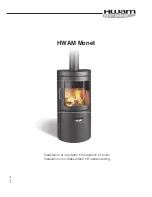
32
restore the appliance.
5.
If the appliance is operated with the siphon empty, there is a risk of leaks of combusted
gas.
4�6
FILLING THE SYSTEM CIRCUIT (APPLIANCE)
After having completed all the connections of the hydraulic, electrical and gas supply
plants, the hydraulic system installation technician can proceed with filling the hydrau-
lic circuit, observing the following stages:
Activate the automatic air vent valves on the system circuit.
•
Fill the hydraulic circuit, ensuring the minimum water content in the plant, and
•
adding, if necessary, to the plant water (free of impurities) a quantity of mono-
ethylene glycol in proportion with the minimum winter temperature in the instal-
lation zone (see table 4.2 Technical data for filling the hydraulic circuit
→
33).
Bring the plant to the correct pressure, making sure that the pressure of the wa-
•
ter in the plant is not less than 1 bar and not over 2 bar.
Possible use of glycol antifreeze
Glycols, normally used to lower the freezing point of water, are substances in an inter-
mediate state of oxidisation which, in the presence of oxidising agents such as oxygen,
are transformed into corresponding acids.
This transformation into acids increases the corrosive nature of the fluid contained
in the circuit. For this reason, mixtures that are commercially available almost always
contain inhibiting substances that are able to control the pH of the solution.
A necessary condition for the oxidisation of the glycol, and therefore its degradation,
is the presence of an oxidising agent such as oxygen.
In closed circuits in which no replenishment of water, and therefore of oxygen, occurs
over the course of time, once the oxygen initially present has reacted, the degenerati-
ve phenomenon of glycol is hugely inhibited.
Most circuits, however, are of the non-sealed type, and therefore receive a more or less
continuous supply of oxygen.
Therefore it is essential, whatever type of glycol is in question, to verify that it is ade-
quately inhibited and that the necessary checks are regularly performed during its
entire period of use.
Antifreeze liquids for cars, which do not contain inhibiting components, are not re-
commended for cooling and heating plants. The manufacturer does not accept any
contractual or extra-contractual liability for damage caused by the use or incor-
rect disposal of glycol antifreeze�
It is equally important to recall that the use of monoethylene glycol modifies the ther-
mophysical characteristics of the water in the plant, and in particular its density, visco-
sity and specific average heat. Always check the date of expiry and/or degradation of
the product with the supplier.
Table 4.2 Technical data for filling the hydraulic circuit
→
33gives the approximate fre-
ezing temperature of the water and consequent increased drop in pressure of the ap-
pliance and of the circuit of the plant, according to the percentage of monoethylene
glycol. This table should be borne in mind when sizing the pipes and water circulator:
for pressure drop calculations, see the data in paragraph 2.4 TECHNICAL DATA
→
11).
Содержание AY Series
Страница 4: ...4 ...
Страница 6: ...6 START OF OPERATING PROCEDURE REFERENCE to another part of the manual or other document ...
Страница 16: ...16 ...
Страница 74: ...74 ...
Страница 81: ...Installation user and maintenance manual AY Condensing line AY series 81 ...
















































